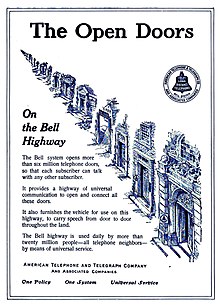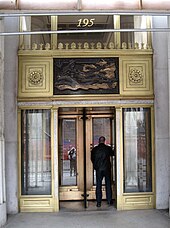Bell System
Parent Bell Telephone Company (1877–1885) | AT&T (1885–1983) | |
The Bell System was a system of
Beginning in the 1910s, American antitrust regulators had been observing and accusing the Bell System of abusing its monopoly power, and had brought legal action multiple times over the decades. In 1974 the
History

In 1877, the American Bell Telephone Company, named after
In 1899, American Telephone & Telegraph (AT&T) acquired the assets of its parent, the American Bell Telephone Company. American Bell had created AT&T to provide long-distance calls between New York and Chicago and beyond. AT&T became the parent of American Bell Telephone Company, and thus the head of the Bell System, because regulatory and tax rules were leaner in New York than in Boston, where American Bell was headquartered. Later, the Bell System and its moniker "Ma Bell" became a term that referred generally to all AT&T companies, of which there were five major divisions:
- AT&T Long Lines, providing long lines to interconnect local exchanges and long-distance calling services, and international lines including submarine cables
- Western Electric Company, Bell's equipment manufacturing arm
- Bell Labs, conducting research and development for AT&T and Western Electric; ownership initially equally split between Western and AT&T
- Bell operating companies, providing local exchange telephone services
- AT&T, the American Telephone and Telegraph company, who led the combined enterprise in planning and finance.
In 1913, the federal government challenged the Bell System's growing
Proliferation of telephone service allowed the company to become the largest corporation in the world until
Formation under Bell patent

Receiving a U.S. patent for the invention of the telephone on March 7, 1876, Alexander Graham Bell formed the Bell Telephone Company in 1877, which in 1885 became AT&T.[2][3][4]
When Bell's original patent expired 15 years later in 1894, the telephone market opened to competition and 6,000 new telephone companies started while the Bell Telephone company took a significant financial downturn.[2][4]
On April 30, 1907, Theodore Newton Vail returned as President of AT&T.[2][4] Vail believed in the superiority of one national telephone system and AT&T adopted the slogan One Policy, One System, Universal Service.[2][5] This became the company's philosophy for the next 70 years.[4] Under Vail, AT&T began acquiring many of the smaller telephone companies including the Western Union Telegraph Company.[2][4]
Kingsbury Commitment
In response to the threat of



Nationwide monopoly
The Bell trademark was used from 1921 through 1969 by both the AT&T corporation and the regional operating corporations to co-brand themselves under a single Bell System trademark. For each regional operating company, its name was placed where "name of associated company" appears in this template version of the trademark.
Bell system telephones and related equipment were made by Western Electric, a wholly owned subsidiary of AT&T Co. Member telephone companies paid a fixed fraction of their revenues as a license fee to Bell Labs.
As a result of this
In 1949, the
The consent decree also forced Bell to make all of its patents royalty-free. This led to substantial increases in innovation, in particular in the electronics and computer sectors.[7] Steven Weber's The Success of Open Source characterizes the consent decree as important in fostering the open source movement.[8]
The Bell System also owned various Caribbean regional operating companies, as well as 54% of Japan's
The 1984
Subsidiaries
Pre-1956 international holdings
Before the 1956 break-up, the Bell System included the companies listed below, plus those listed in the pre-1984 section. Northern Electric and the Caribbean regional operating companies were considered part of the Bell System proper before the break-up. Nippon Electric was considered a more distant affiliate of Western Electric, and through its own research and development adapted the designs of Western Electric's North American telecommunications equipment for use in Japan, which to this day gives much of Japan's telephone equipment and network a closer resemblance to North American ANSI and iconectiv standards than to European-originated ITU-T standards. Before the 1956 break-up, Northern Electric was focused on manufacturing, without significant telecommunication-equipment research & development of its own. The operation of Japan's NTT during the post-World War II occupation was considered an administrative adjunct to the North American Bell System.
- Nortel Networks Corporation, formerly Northern Telecom, an equipment-manufacturing company
- Northern Electric, a former telecommunications equipment-manufacturing subsidiary of Western Electric
- Dominion Electric, a former recording equipment-manufacturing company
- Various former ITT
- NEC, an equipment-manufacturing company in Japan
- Nippon Electric, a former telecommunications equipment-manufacturing company 54% owned by Western Electric
- NTT, a telecommunications company in Japan that was administered by AT&T as part of General Douglas MacArthur's post-WWII reconstruction

Pre-1984 breakup
Immediately before the 1984 break-up, the Bell System had the following corporate structure:
- long-distance carrier
- Illinois Bell Telephone Company
- Indiana Bell Telephone Company, Incorporated
- Michigan Bell Telephone Company
- New England Telephone and Telegraph Company
- New Jersey BellTelephone Company
- New York TelephoneCompany
- Northwestern Bell Telephone Company
- Pacific Northwest Bell Telephone Company
- South Central Bell Telephone Company
- Southern Bell Telephone and Telegraph Company
- Southwestern Bell Telephone Company
- The Bell Telephone Company of Pennsylvania
- The Chesapeake and Potomac Telephone Company
- The Chesapeake and Potomac Telephone Company of Maryland
- The Chesapeake and Potomac Telephone Company of West Virginia
- The Chesapeake and Potomac Telephone Company of Virginia
- The Diamond State Telephone Company
- The Mountain States Telephone and TelegraphCompany
- Malheur Home Telephone Company
- The Ohio Bell Telephone Company
- The Pacific Telephone and Telegraph Company
- Bell Telephone Company of Nevada
- Wisconsin TelephoneCompany
- Other subsidiaries:
- Bell Canada (1880–1975)
- Northern Electric (equipment manufacturing in Canada) (1914–1956)
- Western Electric Co., Inc. (equipment manufacturing)
- AT&T and Western Electric)
- Cincinnati Bell, Inc.(22.7% owned)
- The Southern New England Telephone Company(16.8% owned)
- Bellcomm, Inc. (1963–1972; formed to support the Apollo program)
- Bell Canada (1880–1975)

1984
On January 1, 1984, the former components of the Bell System were structured into the following Regional Bell Operating Companies (RBOCs), which became known as Baby Bells.
- American Information TechnologiesCorporation, branded as Ameritech
- Illinois Bell Telephone Company
- Indiana Bell Telephone Company, Incorporated
- Michigan Bell Telephone Company
- The Ohio Bell Telephone Company
- Wisconsin Bell, Inc.
- American Telephone and Telegraph Company
- AT&T Communications, Inc.
- AT&T Information Systems, Inc.
- AT&T Technologies, Inc.
- Bell Telephone Laboratories, Inc.
- Bell AtlanticCorporation
- New Jersey BellTelephone Company
- The Bell Telephone Company of Pennsylvania
- The Chesapeake and Potomac Telephone Company
- The Chesapeake and Potomac Telephone Company of Maryland
- The Chesapeake and Potomac Telephone Company of West Virginia
- The Chesapeake and Potomac Telephone Company of Virginia
- The Diamond State Telephone Company
- Baby Bells
- BellSouth Corporation
- Southern Bell Telephone and Telegraph Company
- South Central Bell Telephone Company
- Cincinnati Bell, Inc.
- Cincinnati Bell Telephone Company
- NYNEX Corporation
- New York TelephoneCompany
- New England Telephone and Telegraph Company
- Pacific Telesis Group
- Pacific Bell Telephone Company
- Nevada Bell Telephone Company
- Pacific Bell Telephone Company
- Southwestern Bell Corporation
- Southwestern Bell Telephone Company
- The Southern New England Telephone Company
- U S WEST, Inc.
- Northwestern Bell Telephone Company
- Pacific Northwest Bell Telephone Company
- The Mountain States Telephone and Telegraph Company
- Malheur Home Telephone Company
Today
After 1984, multiple mergers occurred of the operating companies and between them, so that some components of the former Bell System are now owned by companies independent of the historic Bell System, including foreign telecommunications firms. The structure of the companies today[when?] is as follows.
Remaining "Regional Bell Operating Companies"
- AT&T Inc., a holding company
- AT&T Corp., a current subsidiary
- AT&T Teleholdings, Inc. (formerly Ameritech Corporation), a current subsidiary, also includes now defunct Pacific Telesis
- Illinois Bell Telephone Company, a regional LEC
- Indiana Bell Telephone Company, Incorporated, a currently existing regional LEC
- Michigan Bell Telephone Company, a regional LEC
- Pacific Bell Telephone Company, a regional LEC
- Nevada Bell Telephone Company, a regional LEC, omitted from the MFJ
- The Ohio Bell Telephone Company, a regional LEC
- Wisconsin Bell, Inc., a regional LEC
- BellSouth LLC, a current subsidiary. Its two operating companies merged into one:
- BellSouth Telecommunications, LLC, a regional LEC, includes Southern Bell & South Central Bell
- Southwestern Bell Telephone Company, a regional LEC
- Bell AtlanticCorporation, a holding company
- NYNEX LLC, a former RBOC holding company
- Verizon New England, Inc., a regional LEC
- Verizon New York, Inc., a regional LEC
- Verizon Delaware LLC, a regional LEC
- Verizon Maryland, Inc., a regional LEC
- Verizon New Jersey, Inc., a regional LEC
- Verizon Pennsylvania, Inc., a regional LEC
- Verizon Washington, D.C., Inc., a regional LEC
- Verizon Virginia, Inc., a regional LEC
- NYNEX LLC, a former RBOC holding company
- Lumen Technologies, Inc. (formerly CenturyLink, Inc.), an independent LEC holding company
- Qwest Communications International, Inc., a holding company acquired in 2011; originally a non-Bell company, acquired and merged U S WEST in 2000.
- Qwest Services Corporation, a holding company within the Qwest corporate structure
- Qwest Corporation, a regional LEC, originally Mountain Bell, includes defunct Malheur Bell, Northwestern Bell, Pacific Northwest Bell
- Qwest Services Corporation, a holding company within the Qwest corporate structure
- Qwest Communications International, Inc., a holding company acquired in 2011; originally a non-Bell company, acquired and merged U S WEST in 2000.
- Other "Bell Operating Companies"

The following telephone companies are considered independent of the
- Cincinnati Bell, Inc., an independent LEC holding company
- Cincinnati Bell Telephone Company LLC, a LEC of which AT&T owned 27.8% before 1984 and thus was left separate in the 1984 break-up
- Consolidated Communications Holdings, Inc., an independent LEC holding company
- FairPoint Communications, Inc., an LEC holding company sold to Consolidated in 2017
- FairPointin 2008
- Consolidated Communications of Vermont Company LLC, a regional LEC created when Verizon New England lines in Vermont were sold to FairPoint in 2008
- FairPoint Communications, Inc., an LEC holding company sold to Consolidated in 2017
- Frontier Communications Corporation, an independent LEC holding company
- Verizonand sold to Frontier in 2010
- Frontier West Virginia, Inc., a regional LEC, formerly C&P Telephone of West Virginia
- The Southern New England Telephone Company, a regional LEC that AT&T owned 16.8% of before 1984 and thus was left separate by the 1984 break-up (subsequently acquired by SBC and then sold to Frontier by the new AT&T after the SBC-AT&T merger)
- Other "Bell System" companies
The following companies were divested after 1984 from
- Nokia Corporationin 2016
- Western Electric Company, Incorporated, a former telecommunications and recording equipment-manufacturing company that ceased to have that name as of the 1984 break-up
- Alcatel-Lucent Bell, a subsidiary of Alcatel-Lucent that was founded in ITTand Alcatel
- Alcatel-Lucent Bell, a subsidiary of Alcatel-Lucent that was founded in
- Bell Telephone Laboratories, Inc., the former AT&T-corporate research unit known as Bell Labs: also spun-off to Lucent Technologies, became Nokia Bell Labsin 2016
- Western Electric Company, Incorporated, a former telecommunications and recording equipment-manufacturing company that ceased to have that name as of the 1984 break-up
- Avaya, Inc., an equipment manufacturing company spun-off from Lucent in 2000
- LSI Corporation, a holding company
- Agere Systems, incorporated in 2000, the former Micro Electronics subsidiary of Lucent; was then spun-off in 2002 and acquired by LSI in 2007
- Systimax Solutions, the
- iconectiv, formerly known as Telcordia and Bell Communications Research (Bellcore)
Beginning in 1991, the
Present-day usage of the Bell name
The Bell System service marks, including the circled-bell logo, especially as redesigned by
Of the various resulting 1984 spinoffs, only
In 1984, each regional Bell operating company was assigned a set list of names it was allowed to use in combination with the Bell marks. By 2022, all these Bell System names had disappeared from the United States business landscape. Cincinnati Bell was the last to use the name, until 2022 when it rebranded to Altafiber, though it still has Cincinnati Bell as its corporate name. Southwestern Bell used both the Bell name and the circled-bell trademark until SBC opted for all of its companies to do business under the "SBC" name in 2002. Bell Atlantic used the Bell name and circled-bell trademark until renaming itself Verizon in 2000. Pacific Bell continued operating in California under that name (or the shortened "PacBell" nickname) until SBC purchased it.[citation needed]
In Canada,
See also
References
- ^ "AT&T History: The Bell System". AT&T Corporation. Archived from the original on September 6, 2008. Retrieved 2008-12-22.
- ^ a b c d e f g "Unnatural Monopoly: Critical Moments". Cato Institute. Archived from the original on 10 September 2008. Retrieved 2008-09-17.
- ^ "Bell's Telephone". Franklin Institute. Archived from the original on 12 September 2008. Retrieved 2008-09-17.
- ^ a b c d e f "AT&T Milestones in AT&T History". AT&T. Archived from the original on 28 September 2008. Retrieved 2008-09-17.
- ^ a b "AT&T History: The Bell System". AT&T. Archived from the original on 3 October 2008. Retrieved 2008-09-17.
- ISBN 978-0-06-010540-2.
- S2CID 229080411.
- ^ Weber, Steven (2004). "The Success of Open Source". Harvard University Press. Retrieved 2021-01-04.
- ^ USPTO record for trademark serial no. 73727728 (example "Bell" registration originally held by Pacific Telesis): "Registration is nationwide, but is subject to the condition that registrant shall use the mark only in conjunction with one or more of the following modifiers; "Nevada Bell", "Pacific Bell", "Pacific Telephone", "Pacific Telesis", or "PacTel". Use of a modifier shall be considered to be in conjunction with the mark if it is used in sufficient proximity to the mark such that a reasonable observer would normally view the mark and the modifier in a single visual impression and would recognize that both the mark and the modifier are used by registrant. Registrant's right to exclusive use of the mark is subject to the rights of the [other RBOCs], to which concurrent registrations in the mark have also been issued, to use the mark in conjunction with one or more of the modifiers specified in those registrations[...]"
